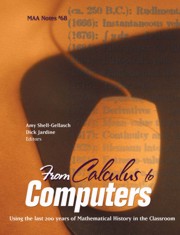Book contents
- Frontmatter
- Preface
- Contents
- Introduction
- I Algebra, Number Theory, Calculus, and Dynamical Systems
- II Geometry
- III Discrete Mathematics, Computer Science, Numerical Methods, Logic, and Statistics
- 9 Using 20th Century History in a Combinatorics and Graph Theory Class
- 10 Public Key Cryptography
- 11 Introducing Logic via Turing Machines
- 12 From Hilbert's Program to Computer Programming
- 13 From the Tree Method in Modern Logic to the Beginning of Automated Theorem Proving
- 14 Numerical Methods History Projects
- 15 Foundations of Statistics in American Textbooks: Probability and Pedagogy in Historical Context
- IV History of Mathematics and Pedagogy
- About the Authors
14 - Numerical Methods History Projects
from III - Discrete Mathematics, Computer Science, Numerical Methods, Logic, and Statistics
- Frontmatter
- Preface
- Contents
- Introduction
- I Algebra, Number Theory, Calculus, and Dynamical Systems
- II Geometry
- III Discrete Mathematics, Computer Science, Numerical Methods, Logic, and Statistics
- 9 Using 20th Century History in a Combinatorics and Graph Theory Class
- 10 Public Key Cryptography
- 11 Introducing Logic via Turing Machines
- 12 From Hilbert's Program to Computer Programming
- 13 From the Tree Method in Modern Logic to the Beginning of Automated Theorem Proving
- 14 Numerical Methods History Projects
- 15 Foundations of Statistics in American Textbooks: Probability and Pedagogy in Historical Context
- IV History of Mathematics and Pedagogy
- About the Authors
Summary
Introduction
Hermite, Runge, Birkhoff, and Shoenberg are just four of the many mathematicians of the past 200 years who contributed to the field of numerical analysis. In the numerical methods course described in this article, students met Charles Hermite (1822–1901) while studying the interpolating polynomials bearing his name. Students became acquainted with Carl Runge (1856–1927) as they did the historical research to learn what applications motivated the development of his popular method for approximating the solution to differential equations. Isaac Shoenberg (1903–1990) and Garrett Birkhoff (1911–1996) had different purposes in developing and applying splines, just one of the mathematical methods created to support the American wartime effort of the 1940s. Students study splines in this and other numerical analysis and mathematical modeling courses ([1] and [5] are typical texts), but in this one they learn the context for the historical development of the mathematics.
Projects and other history-based course activities provide an opportunity to bring to life the topics of a numerical analysis course. A brief overview of history-based projects included in a numerical methods course is given here. All the projects are described in the paper; one of the course projects is contained in an appendix. The historical components of the projects are the focus, however other historical activities included in the course are also presented, hopefully providing the interested reader with resources and ideas for implementation in other courses.
- Type
- Chapter
- Information
- From Calculus to ComputersUsing the Last 200 Years of Mathematics History in the Classroom, pp. 161 - 164Publisher: Mathematical Association of AmericaPrint publication year: 2005



